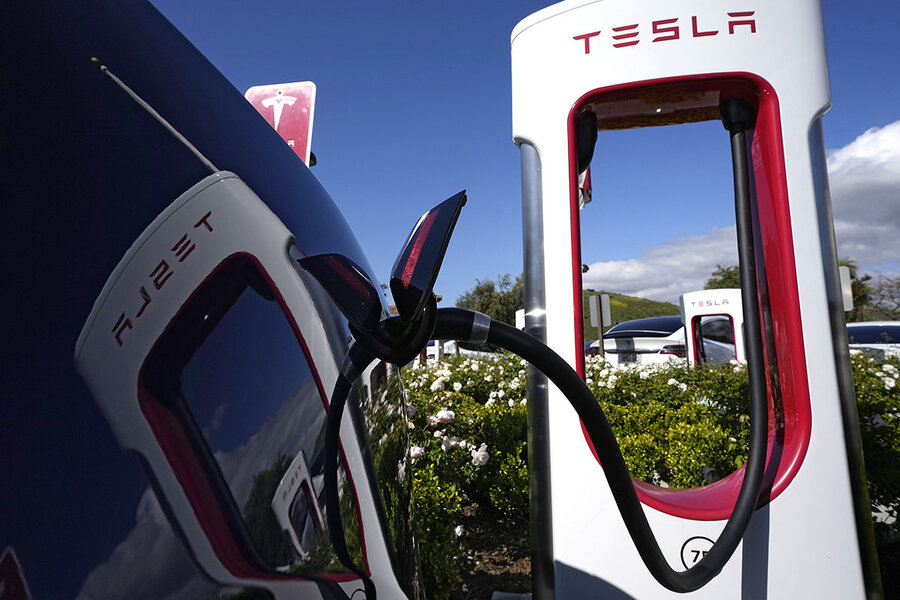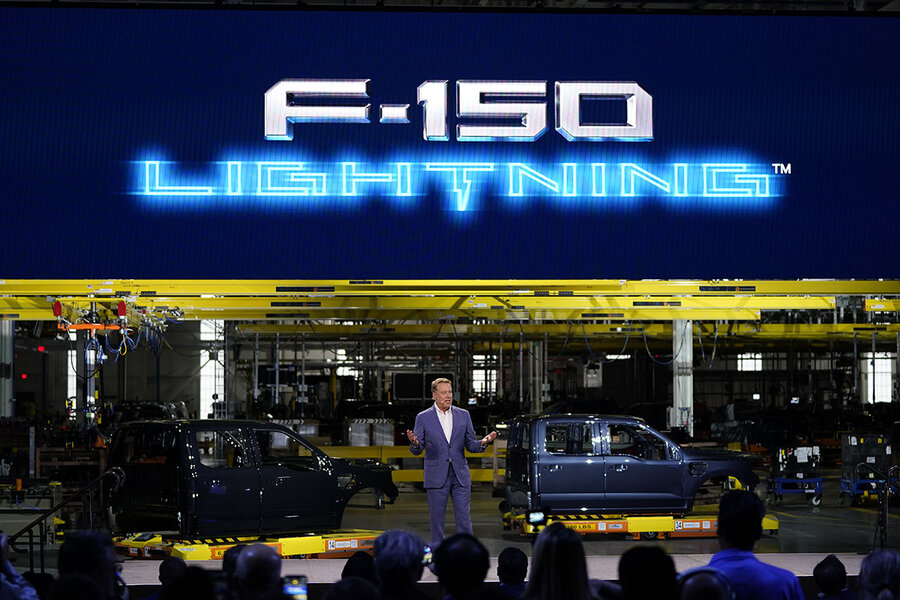A rough patch on the road to an electric car future
Loading...
| Brighton, MICH.
The likely cars of the future – electric vehicles – face a challenge: Sales aren’t keeping up with expectations. Automakers are pausing to take a new, hard look at the EV market.
Yet the story is more about bumps in the road than about a total breakdown. EV sales are up 50% compared with those of last year, with more than 1 million forecast to be sold this year – a first. But there’s been no breakthrough to make EVs a must-have for the average household. Inventories of unsold cars are building up.
Why We Wrote This
A story focused onElectric vehicles have hit a much-publicized rough patch, as sales fail to match industry hopes. The challenge: enticing a new, more skeptical kind of buyer for green cars.
That’s a problem for Tesla, which is producing at such a mass scale that it can afford to cut prices and still make a profit. It’s a disaster for Detroit’s legacy automakers, which are turning out EVs on a much smaller scale and losing money on every one they sell.
The industry has nearly run out of early adopters, people who bought EVs because they loved the technology. Now, it has to convince a new kind of customer who is intrigued by electric cars but more skeptical, especially about their high prices and uncertainty about charging them on the road.
“I’m not doom and gloom,” says auto analyst Stephanie Valdez Streaty. “This is a huge transition, and it’s so complex. It’s a change in lifestyle.”
American flags are flapping. Red, white, and blue banners in the lot urge customers to consider “New car” and “SUV.” And electric vehicles?
Not so much.
“Come back in a few months, and we’ll have a story to tell,” says Dominic Policella, general sales manager at Brighton Ford here in Brighton, Michigan. At least it’s an answer. A General Motors dealer in Livonia won’t return calls. Even Tesla, the leading electric vehicle maker in the United States, ignores repeated requests for interviews.
Why We Wrote This
A story focused onElectric vehicles have hit a much-publicized rough patch, as sales fail to match industry hopes. The challenge: enticing a new, more skeptical kind of buyer for green cars.
Why? Sales of EVs aren’t keeping up with expectations. And automakers are pausing to take a new, hard look at the market.
There’s plenty to brag about: EV sales are up 50% compared with those of last year, with more than 1 million forecast to be sold this year – a first. And over a vehicle’s lifetime, battery power significantly reduces greenhouse gas emissions, compared with gasoline. But there’s been no breakthrough to make EVs a must-have for the average household. Inventories of unsold cars are building up.
That’s a problem for Tesla, which is producing at such a mass scale that it can afford to cut prices and still maintain profitability. It’s a disaster for Detroit’s legacy automakers, which are turning out EVs on a much smaller scale and losing money on every one they sell. Their conundrum: How much money are they willing to lose to be a part of the future?
“They’re in a big, big squeeze” says Arun Kumar, a partner and managing director in the automotive and industrial practice at AlixPartners, a global consulting firm. To avoid falling behind Tesla and EV-only manufacturers in China, legacy automakers need to accelerate their efforts to reach mass scale in electric cars, even if it means losses for several years.
Instead, GM and Ford are slowing their EV transition. And Stellantis, an EV laggard, is pushing a new kind of hybrid technology rather than a battery-only solution, starting with its Ram pickup trucks. Last month, Ford announced it was delaying its $12 billion investment in battery plants and other EV efforts. GM has pushed back the introduction of several new EVs, including what was supposed to be a relatively low-priced electric version of the Chevrolet Equinox sport utility vehicle.
“Our commitment to an all-EV future is as strong as ever,” GM CEO Mary Barra told analysts last month. But the market is “a bit bumpy,” she added. Mercedes-Benz cited a “brutal” EV market as it announced a 7% drop in earnings for the third quarter.
Part of the challenge lies with the changing consumer base. The industry has nearly run out of early adopters, people who bought EVs because they loved the technology. Now, carmakers have to convince a new kind of customer who is intrigued by electric cars but more skeptical.
In October, nearly 1 in 3 new car buyers was very likely to consider an EV – an all-time high, according to surveys of customers by J.D. Power, a consumer analytics firm. But only a third of those customers ended up going electric. Their biggest concern lies not with the cars themselves but with the prospect of charging them on the road.
The public charging network is not reliable enough and not growing fast enough to keep up with the number of new EVs hitting the road, says Elizabeth Krear, vice president of electric vehicle practice at J.D. Power. One in five charging attempts fails.
The Biden administration along with automakers and even oil companies are pouring in money to grow and upgrade the charging network. Ford, GM, and other companies have signed on to use Tesla’s extensive network of charging stations. But such efforts will take time.
Then there’s the price challenge. EVs generally cost thousands more than their gas-powered versions. Tesla price cuts have brought prices down to the point where premium EVs are now on par with gas-powered counterparts, when measured by total ownership costs, according to J.D. Power. But at the mass market level, gas-powered models are still cheaper.
Government intervention complicates the picture. On the one hand, the federal government is encouraging the transition to battery-powered transportation by offering up to a $7,500 tax credit for purchases of qualifying EVs, and nearly 20 states offer additional tax breaks. On the other hand, it could force the technology on reluctant consumers, sparking a backlash. As things stand now, emission standards under the Biden administration means automakers effectively will be required to ensure that two-thirds of their new car sales are EVs by 2032.
“Silly,” says Ashley Nunes, director for federal policy at the Breakthrough Institute, an environmental research organization based in Oakland, California. “Many of these automakers will effectively be forced to underprice their EVs by offering huge discounts and price cuts just to comply with the standard that the administration has put out. But that is a one-way ticket to bankruptcy.”
Instead, government should incentivize a competition among manufacturers, he says. “We need a space race, if you will, for the cheap electric car – not just an electric car that consumers can buy but an electric car that they want to buy.”
Unforeseen events could change the EV calculus: a battery breakthrough, for example, or a huge hike in gasoline prices. For the moment, though, it looks as though automakers will face years of steady but less-than-spectacular growth in EV sales.
“I’m not doom and gloom,” says Stephanie Valdez Streaty, director of industry insights for Cox Automotive, an automotive services and technology provider. “This is a huge transition, and it’s so complex. It’s a change in lifestyle.” By 2030, she forecasts, EVs will account for close to half of new cars sold in the U.S.









